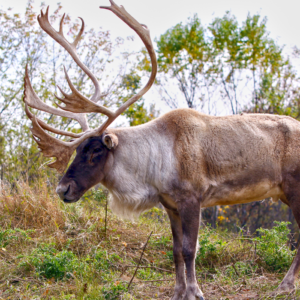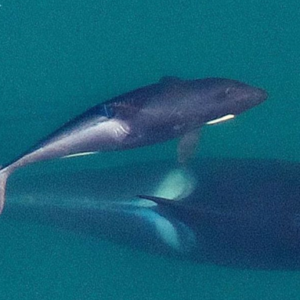Swimming with Species – Orcas
Today’s species is the Orca!
Orcas, also known as Killer Whales, are among the best-known marine animals. They are iconic mammals of Canada’s wildlife, and hold an important symbolism among the Native communities. Orcas are super easy to identify with their unique tuxedo-like colouration and white “eye” patches. Since they live in all five oceans, we can find them to the east, west, and north of Canada!
Now, we really should call them Orcas because “killer whales” is quite misleading. You see, Orcas are the largest members of the dolphin family, (not whales)! By large, we’re talking males up to 9 meters long and weigh 6 to 9 thousand kilograms, that’s 7-10 tons! Females are a bit smaller, and are about 7 meters long and 4 to 7 thousand kilos (5-7 tons).

Photo by Nicole Peshy, an Orca hunting a Sea Lion.
Like most members of the dolphin family, Orcas are highly social. They live in groups called a pod which can consist of 10 to 40 related individuals. Research has found that there are different “types” of pods, for which scientists have used to classify and identify groups of Orcas. These are; Northern and Southern Resident type, Northern and Southern Transient type, and Offshore type. Differences between types can be subtle such as variations in vocal patterns and dorsal fin shapes, or more pronounced such as their preferred diet. Offshore and Residents Orcas will feed predominantly on fish; schooling fish for the Offshores, and coastal fish and squid for the Resident Orcas. Transient pods, on the other hand, feed almost exclusively on other marine mammals. Speaking of food, Orcas got their nicknames, killer whales, from their hunting strategy. Orcas are apex predators, or top predators of the oceans, and hunt in packs, quite fiercely.
When a pod isn’t hunting, they spend time socializing with each other. They’ll travel, rest, explore, and play together. The most famous play behaviour is called breaching; when they dived out of the water’s surface into the air with leaps and twirls. In essence, they need to breach to come to the surface for respiration, but, they do so with fantastic style! Orcas aren’t the only ones though, most whales and dolphins perform these jumps, twirls and tail slaps. In addition, Orcas communicate with echolocation, which mean the use of sound waves to locate and identify objects within their surroundings. This helps them navigate for foraging and just for an Orca to tell another Orca their location.
Orcas have long lifespans! They can live up 40-50 years old. However, females tend to live longer and can reach up to 80 years of age. Both females and males reach sexual maturity in their “teens” being 12-17 years old. Pods of different families will find one another to mate with. This keeps their genetic make-up stronger, versus if they were to inbreed. The gestation period is a little more than a year with 17 months. Babies are born with the same colouration as adults, so they really do look like miniature versions of their mother!

Photo by Eileen Redding
As social animals, offspring need their mother and pod members to learn behaviours, feed, and be safe from predators. It takes about a year before a baby is weaned, therefore it is crucial that mom and baby stay together during this time. If a baby gets lost, or gets separated from their mom, they will have a high chance of dying, not knowing how to survive on their own. Once weaned, the offspring stays with its natal pod for life.
Orcas intrigue scientists with their complex behaviours. They are still so much to learn about them since scientists have only be able to conduct studies close to shores, and/or in captivity. Not only are parenting behaviours observed among pods, but pod members have been observed to teach younger members foraging and hunting skills. Pods of different “types” developed their own “dialect” for whistles, calls, and clicks, which is passed on to their offspring! But most fascinating is their ability to mourn. For example, when a baby dies, a mother will carry the body for days until she has “moved on”. This has been called a “Tour of Grief”.
According to the ICUN, there is insufficient data to conclude a species assessment status other than “Data Deficient (DD)”. However, Orcas are still victims to many threats, most of them human-related. For one, commercial fisheries contribute to increased accidental net entrapment and decreased prey availability to native wildlife. Oil spills and toxic build-up via human waste affects all large species like Orcas, because toxins will accumulate in dangerous amounts within their fat cells. In addition, just as there are more cars on the roads, there are more ships asea. We don’t think of it; however, water traffic affects water acoustics, which then effects echolocation for Orcas and all other species that use this method of communication!
Fortunately, they are people who do not take the threat of Orcas’ disappearance lightly. Conservation organizations like Nature Canada are pressing governments to urge the continuation of research projects, recovery plans, and imply more wildlife protection. Do you want to help out but think “oh well I’m just one person, right?” Wrong! You can help! Every step counts. Become more aware of what you’re buying and try to buy environmentally friendly items. Support sites such as Nature Canada that educate the public about our endangered species and provide guides to good stewardships. Participate in Orca educational programs with your provincial wildlife organizations. And lastly, spread the word! Post, share, and tweet about saving orcas.
References:
https://naturecanada.ca/what-we-do/naturevoice/endangered-species/know-our-species/orca/
http://www.iucnredlist.org/details/15421/0
https://animaldiversity.org/accounts/Orcinus_orca/
https://bc.ctvnews.ca/orca-s-tour-of-grief-over-after-carrying-dead-calf-for-nearly-3-weeks-1.4049902



